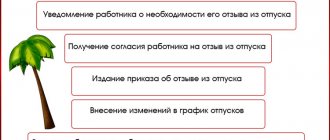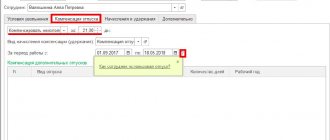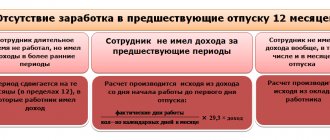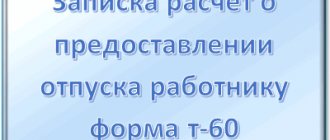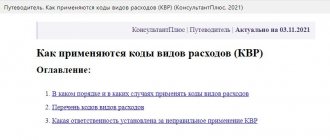How to divide the vacation period
According to the Labor Code of the Russian Federation, annual paid leave can be divided into parts by agreement between the employee and the employer (Article 125). But only on condition that at least one of the parts lasts 14 days. The rest of the period is divided into any number of parts.
For example, an employee has one part of vacation for at least 14 days under Article TC 125. After some time, he took out two more vacation periods of a week each. The Labor Code does not prohibit taking even 1 paid day off, if so included in the vacation schedule. However, in practice, even if an employee has taken 14 days of vacation according to the Labor Code, employers are extremely reluctant to divide the vacation into periods of 1 to 5 days, since this involves paperwork. In addition, when drawing up a schedule, the employer assesses the production need for a particular employee in a specific period of time, and frequent and short breaks in work negatively affect the work of the company. In many organizations, during the absence of one or another employee, it is necessary to appoint a replacement, which complicates the procedure for registering leave. In particular, such difficulties are encountered in organizations whose functioning occurs only in the presence of an established quorum. For example, various expert commissions.
Results
Rostrud does not prohibit dividing vacation into parts, provided that both the employer and the employee agree to this, and one of the parts of the vacation will not be less than 14 days. The remaining vacation days can be divided into at least 1-2 days per month. Vacation can start on any day of the week, even on a weekend. However, you cannot provide vacation only on weekends.
Sources: Labor Code of the Russian Federation
You can find more complete information on the topic in ConsultantPlus. Free trial access to the system for 2 days.
How to apply
The Labor Code of the Russian Federation stipulates whether annual paid leave can be divided into four equal parts - yes, subject to the 14-day rule. No later than two weeks before the start of the new year, the company draws up a vacation schedule. The employer approves this document taking into account the opinion of the staff and the production needs of the enterprise. It is not necessary to familiarize staff with this document, but some enterprises prefer to do this with a signature in order to avoid misunderstandings.
In fact, how an employee can manage his vacation is his personal business, but the division of vacation should be agreed upon with the employer and documented. Often employees write a corresponding statement addressed to the manager.
And although the Labor Code of the Russian Federation approves whether the division of vacation into parts is allowed (yes, it is allowed), the parties need to agree on everything in advance. At least two weeks before the start of the vacation, the employer sends the employee a corresponding notice, where the employee puts a mark on familiarization.
ConsultantPlus experts examined the features of dividing annual leave into parts. Use these instructions for free.
If an employee wants to be given an unscheduled break, he fills out a corresponding application. If there are no problems in the organization, the manager will meet halfway and sign the application. It doesn’t matter how many parts vacation can be divided into according to the Labor Code in 2022, all rest periods must be reflected in the working time sheet. For this, the code “OT” or “09” is used.
Dividing vacation into parts
Annual leave may be divided into parts or extended. An employee can go on vacation at one time, either for the total duration or in parts. However, vacation can only be shared by agreement of both parties - the employer and the employee.
At least one part of the divided vacation must be at least 14 days. And the employee can use the remaining days as he wants (Article 125 of the Labor Code). Important - the specified 14 days must be provided in a row for the current working year. This position of the Ministry of Labor is indicated in Letter dated September 24, 2019 No. 14-2/OOG-6958.
The explanation is as follows. The mandatory two weeks of vacation must only include days during the current work period. If, for example, there are 7 days for the previous period and 7 for the current period, the requirement of Part 1 of Art. 125 TK.
Thus, when applying for leave for 14 days, they must be provided against the leave of the current working year, even if there are days left for the previous period. But it is important not to forget about unused days - you need to provide them separately or together with the vacation of the current period.
For example, an employee has 7 days from the previous period, which he wants to add to his vacation for the current year. Then the vacation will be 21 days - 14 days for the current year and 7 days for the last one.
Is an employee obliged to divide the vacation period at the request of the employer?
Quite often, due to the specifics of the company’s activities, it is difficult for a manager to let an employee go for 28 days in a row. In such cases, unscrupulous employers try to force the employee to divide this period into parts, citing how vacation can be divided into parts under the Labor Code in 2022 - into 14 consecutive days and other periods. But they have no legal grounds for such coercion, since this contradicts the norms of the Labor Code of the Russian Federation and the explanation given in the letter of Rostrud No. 2143-6-1 dated July 17, 2009.
As for days off that fall during rest periods, the employer does not have the right to force the employee to include days off at this time. For example, when an employee wrote an application for the period from Monday to Friday. In fact, he rests for 7 days, but he will only be paid for 5 days.
Only the employee decides how to divide the vacation into parts: according to the Labor Code, he is obliged to take at least one day off for two weeks without a break. If an employee divides his rest time into several parts that run in a row, but do not include weekends or holidays, then with a high degree of probability the employer will not sign such a statement. HR specialists will ask you to rewrite the application and include days off.
Article 125. Division of annual paid leave into parts. Review from vacation
Determination of the Constitutional Court of the Russian Federation dated October 23, 2014 N 2302-On part two of Article 125 of the Labor Code of the Russian Federation, which states that recall of an employee from vacation is allowed only with his consent; the part of the vacation not used in this regard must be provided at the employee’s choice at a time convenient for him during the current working year or added to the vacation for the next working year.
Ruling of the Supreme Court of the Russian Federation dated June 16, 2015 N 301-KG15-5751 in case N A39-3748/2014
In these circumstances, the courts, guided by the provisions of Articles 106, 107, 114, 122, 123, 124, 125, 136, 260 of the Labor Code of the Russian Federation, Article 11.1 of the Federal Law of December 29, 2006 N 255-FZ “On compulsory social insurance in case of temporary disability and in connection with maternity”, as well as the explanations set out in paragraph 20 of the resolution of the plenum of the Supreme Court of the Russian Federation dated January 28, 2014 N 1 “On the application of legislation regulating the work of women, persons with family responsibilities and minors”, came to the conclusion that the simultaneous use of two or more vacations is not provided for by the labor legislation of the Russian Federation, and the fund rightfully refused to allow the company to take into account the unreasonably incurred expenses for the payment of child care benefits during the time the named employees were on the next main vacation.
Determination of the Constitutional Court of the Russian Federation dated March 26, 2020 N 712-O
ARTICLE 125 OF THE LABOR CODE OF THE RUSSIAN FEDERATION The Constitutional Court of the Russian Federation, composed of Chairman V.D. Zorkin, judges K.V. Aranovsky, A.I. Boytsova, N.S. Bondar, G.A. Gadzhieva, Yu.M. Danilova, L.M. Zharkova, S.M. Kazantseva, S.D. Knyazeva, A.N. Kokotova, L.O. Krasavchikova, S.P. Mavrina, N.V. Melnikova, Yu.D. Rudkina, V.G. Yaroslavtseva,
Determination of the Supreme Court of the Russian Federation dated November 14, 2008 N 5-В08-84
In accordance with Art. 125 of the Labor Code of the Russian Federation, by agreement between the employee and the employer, annual paid leave can be divided into parts. In accordance with orders No. 189/ok of October 18, 2005 and 198/ok of October 25, 2005, M. was provided with 6 calendar days on account of the next paid leave.
Decision of the Disciplinary Board of the Supreme Court of the Russian Federation dated September 28, 2021 in case No. DK21-67
The conclusions of the KKS are motivated by the systematic violation of L.L. Alushkina. procedural norms when considering court cases and non-compliance with the rules of labor legislation and the internal rules of the court. In its decision, the QCC referred to Articles 118, 120 - 122 of the Constitution of the Russian Federation, Articles 3, 121, 22 of the Law of the Russian Federation of June 26, 1992 N 3132-I “On the Status of Judges in the Russian Federation” (hereinafter referred to as the Law on the Status of Judges ), articles 1 - 6, 22 of the Code of Judicial Ethics (approved by the All-Russian Congress of Judges on December 19, 2012), articles 165, 259 of the Criminal Procedure Code of the Russian Federation (hereinafter referred to as the Code of Criminal Procedure of the Russian Federation), articles 106, 107, 123, 125, 128, 189 of the Labor Code of the Russian Federation (hereinafter referred to as the Labor Code of the Russian Federation), paragraphs 6, 17 of the resolution of the Plenum of the Supreme Court of the Russian Federation dated June 1, 2022 N 19 “On the practice of courts considering petitions for investigative actions related to the restriction of the constitutional rights of citizens ( Article 165 of the Code of Criminal Procedure of the Russian Federation), Model internal rules of the court (approved by Resolution of the Council of Judges of the Russian Federation dated April 18, 2003 N 101) and internal rules of the court.
What affects the amount of vacation pay?
So, based on the methodology for calculating vacation pay, we see that the following factors influence the amount of vacation pay:
1) Availability of bonuses in the billing period (i.e., the period taken to calculate vacation).
Bonus payments for seasonal business employees (selling beer, ice cream, construction materials) may vary depending on the time of year. Accountants, as a rule, receive bonuses based on the results of the annual report.
2) Change of employee status in the billing period.
An employee may be promoted or transferred to a lower-paid job, which may affect his average earnings.
3) Availability of non-working holidays in the vacation month;
Non-working holidays falling during the period of annual basic or additional paid leave are not included in the number of calendar days of leave (Article 120 of the Labor Code of the Russian Federation). For example, in January 2022, the “richest” year for holidays, the cost of a working day will be high (in January 2022 - 17 working days), and holidays will only lengthen vacation time, but will not be taken into account when calculating vacation payments.
Weekends (as opposed to non-working holidays) are subject to inclusion in the number of calendar days of vacation and, therefore, their transfer does not affect the end date of the vacation.
If there are holidays during the vacation period, the holiday adds an additional non-working day to the vacation.
Please note that the employee’s leave was not extended for the non-working days declared by the President of the Russian Federation on June 24 and July 1, 2022 (Letter of the Ministry of Labor dated June 17, 2020 No. 14-1/B-733).
4) Division into parts (the so-called “crushing” of the holiday).
The total duration of annual leave is usually 28 calendar days. By agreement between the employee and the employer, annual paid leave can be divided into parts, one of which must be at least 14 calendar days (Part 1 of Article 125 of the Labor Code of the Russian Federation). Basically, employees go on vacation for 2 weeks, so that a long absence of an employee does not affect the normal course of work; vacations can either increase or decrease the amount of vacation pay.
Procedure for dividing vacation
Only by agreement with the employer can an employee share his vacation. This clearly follows from the provisions of Article 125 of the Labor Code of the Russian Federation.
But how should this consent be obtained by the employee? There is not a word in the code itself about the form of such consent.
Guided by common sense and legal norms, two possible forms can be distinguished, which will be described in detail below.
Oral
Something like an oral agreement is concluded between the employee and the employer , guaranteeing the employee the fulfillment of his request. True, this is possible mainly in small enterprises, when maintaining unnecessary documentation is impractical for many reasons. In other cases, the second form is the best solution.
Written
The employee can state the essence of his request in a statement addressed to the manager. The scale of the problem allows you to save on paper, that is, instead of A4 paper, you can use A5. And there are unlikely to be any difficulties with the details of the form. All you need is:
- addressee (manager);
- addressee – sender (employee, indicating position (profession));
- name of the type of document (application);
- text;
- signature.
IMPORTANT. The text of the application does not necessarily explain what caused the desire to divide the vacation into parts. But it is better to do this anyway, since the employer can satisfy the request if the desire to split up is caused by objective reasons. Whereas purely personal motives may go unnoticed.
The picture below shows a sample application for dividing the vacation into parts:
